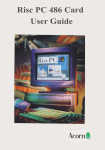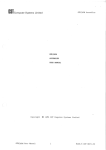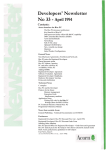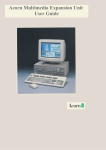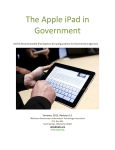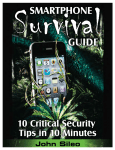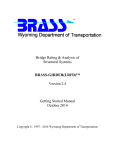Download Acorn Risc PC User guide
Transcript
Acorn Risc PC Release note Contents Page number Introduction 2 Returning your computer under warranty 2 Software issues 3 Purchasing additional memory modules 11 Correcting your system configuration 13 Updates to the !Products database 15 Report form 19 1 Introduction Introduction This Release note describes • features of the operating system which have not been covered in the manuals • operational aspects which allow users to make the best use of their system • known problem areas within the hardware and software. The applications on this computer have not been tested for use on any earlier versions of the operating system. RISC OS 3 version 3.5 has not been tested for use in safety critical applications. Servicing your computer under warranty All Risc PCs are provided with 12 months on-site service and hotline support. After you have unpacked your computer, please fill in and return your Owner Registration Card and On-site Service Registration Card. Make a note of the serial numbers of the computer, mouse and keyboard, and keep these details somewhere safe. It is important that the mouse or keyboard serviced under warranty is the one originally sold with the computer. 2 Acorn Risc PC Release note Software issues ! Draw Saving files for loading by other applications The Drawfile format has been extended (since !Draw version 0.88) to include a new 'type 11' object which records details about the page size and orientation of the file. Some applications may fail to load Drawfiles containing this new object. To overcome this problem, load the Drawfile into Draw, choose Select all and save the selection; this saves a Drawfile without a type 11 object. Loading files into Acorn Desktop Publisher Before you save a file from Draw to load it into Acorn DTP, convert to path any rotated text, otherwise Acorn DTP will not display or print the rotated text. Over-magnifying If you scale up an object in !Draw and then highly magnify the view, the object may disappear. To retrieve the object, undo these operations. Reduce the object's scaling so that it doesn't disappear again. Importing sprites Importing sprites without palettes may result in the sprite colours appearing incorrect. !Boot - Fonts Additional fonts are now added to the computer using the Fonts screen in the !Configure application. The !Configure application is started by double-clicking on !Boot. 3 Software issues Do not use an old type !Fonts application You must not use a !Fonts application designed for use with RISC OS 2.00 or 2.01. They are not compatible with the fonts in the ROM and the hard disc. If you accidentally use one of these old type ! Fonts, you will no longer be able to use any of the ROM fonts. The only way to cure this problem is to reboot the computer. To use the fonts contained in an old type !Fonts application, they must be moved over into a new type !Fonts application. The RISCOS 3 User Guide shows you how to do this Fonts settings are now in points not pixels The fonts settings of !Configure are in points on your computer, not in pixels as on RISC OS 2 or RISC OS 3 version 3.00. A given number of points is much larger than the same number of pixels, so be careful to set these configuration details to sensible values The computer is supplied with the cacheing parameters set to 32 points with no sub-pixel anti-aliasing. Increasing these to 64 points for anti-aliasing and cacheing bitmaps, and 12 points for horizontal sub pixel anti-aliasing will improve the display quality for a reasonable range of text likely to be used on the desktop. Non-Acorn SCSI cards If you have a non-Acorn-designed SCSI card fitted, you should not use !Configure to alter the number of SCSI disc drives, as the usage of CMOS RAM varies between manufacturers. Refer to you card's documentation for configuration instructions. Concealing the !Configure application The !Configure application is started by double-clicking on the !Boot icon. If you wish to remove this facility move !Configure from !Boot into another directory or onto floppy disc. !Configure can be found in $. !Boot.Resources. To restore !Configure, move it back into S.!Boot. Resources. 4 Acorn Risc PC Release note DOS-formatted floppy discs Dismounting DOS floppy discs Mounting many DOS format floppy discs at once can generate the error Too many discs'. If you encounter this, click on the error box OK button, press F12 to go to the command line, then type *Shut and press Return twice (this enters the command and returns to the desktop). Note that *Shut should be avoided in normal use, as it closes files that applications may expect to be left open. Names to avoid calling your DOS discs RISC OS disc drive numbers :0 to :7 can also be referred to as :A to : G. Normally this does not cause a problem. However it is possible to have a DOS disc that uses these names as disc labels. If you get peculiar behaviour with a DOS disc, such as getting 'Disc drive not known' errors, then this may be the problem. Cure this by taking the DOS disc to a PC (or use Acorn PC Soft) and giving it a longer name using the 'label' command. Unrecognised DOS disc names Some DOS utilities allow floppy discs to be given names including a '. ' character, for example AB.CD. Such disc names are not recognised by the Filer, which may produce errors such as 'Please insert disc 'AB". Using DOS discs with very little memory free If your computer has very little free memory, it is possible that a DOS disc won't be recognised. If you find that a known good DOS disc gives the error 'Disc not recognised - has it been formatted?' then check to see if you are low on memory. Acorn PC Soft (PC Emulator) — UK keyboard layout The Acorn Risc PC keyboard has a UK layout keyboard. DOS running on PC Soft should always be installed with a UK layout (enhanced) keyboard. The actual method of configuration a UK keyboard varies between DOS versions, but commonly the command to use is 'keyb uk'. 5 Software issues Acorn PC Soft - locked hard disc If you run PC Soft on a computer with a locked hard disc you cannot write to the hard disc DOS partition. If you want to write to the hard disc, you must quit PC Soft, unlock the hard disc, and then start PC Soft again. Pinboard Quitting Pinboard with iconised windows You should not normally quit the Pinboard using the Tasks display. However if you do, make sure that any iconised windows are opened before you quit the Pinboard application. If you quit the Pinboard from the Task manager/Tasks window while you have windows iconised, these windows disappear. If these windows contain modified data, this data can be lost. Removing the backdrop to improve available memory The !MemNow application gives you early warning when memory is running low. !MemNow can be found in the Diversions directory. If your computer is running low on memory, removing the backdrop can release quite a large chunk. Depending on the screen mode and which backdrop is being used, it can take up to 256K to operate. Using *Configure MonitorType In normal use you should not need to use *Configure MonitorType on your Acorn Risc PC. However, if you do wish to use this facility you might wish to note the following: 6 • When a monitor is configured, !Boot performs a * LoadModeFile. This replaces the configured monitor type with monitor type 7; this disables your monitor type setting. To avoid this, use !Boot to configure the monitor type to Auto before using *Configure MonitorType. • Monitor type 7 is used as a special monitor type meaning 'this monitor's behaviour is determined by a loaded mode file'. You must not configure this monitor type using *Configure MonitorType. Acorn Risc PC Release note • When a monitor type is configured using *Configure MonitorType, many of the facilities of the Acorn Risc PC display selection interface are not available. In particular the Display manager window will not be able to present a list of available resolutions and colours. However, you can still select the 'old-style' modes by mode number from the icon bar menu. Selecting modes by mode number To select a screen display mode by mode number, use the Mode entry on the Display manager menu. Clear the text in the writeable field (you can use Ctrl-U to do this quickly) then type in the mode number of the mode you want. Most monitors cannot display all the numbered modes. If your monitor cannot display the mode selected then an alternative mode with the same number of colours will be chosen automatically. Mode independence and monitors As monitor technology has advanced, the ability to display some of the older screen modes has been dropped. For example modes 16, 17 and 24 cannot be displayed on the AKF60. Desktop icons change unexpectedly If desktop icons change appearance unexpectedly, the cause is probably an application which has redefined some of the desktop sprites. You should upgrade to a newer version of the application. Task Manager — resizing tasks and slots You may notice when trying to resize a task or trying to set the Next slot size from the Tasks window that you just can't select the amount of memory you want. Do not worry. This is a side effect of the way the Tasks window scales the mouse movement to enable computers with a lot of memory to be usable. For small amounts in a slot you have accurate control, but as the slot gets larger the changes in the amount of memory get coarser and coarser. If this were not done then to drag a slot of 32MBytes would require the mouse to be moved 3 metres! 7 Software issues Using PostScript printers on a locked disc Although you can print to a PostScript printer with no problems whilst the hard disc is locked, you cannot add a new PostScript printer. You also cannot use the Save choices option. NFS Filer — Desktop saving If you have applications in the root directory of an NFS mount which you wish to store in a Desktop boot file, you should edit the saved desktop boot file to remove the Filer_Boots of those applications, or move them after the line where the mount is mounted. This ensures that the NFS mount is present when these applications are Filer Booted. Using Acorn Desktop Publisher When in 32 thousand or 16 million colour screen modes Desktop Publisher takes a very long time to start. Changing to these screen modes also increases the time to process the display change. ChangeFSl — Decompressing JPEG Files There are some JPEG files available which don't conform to the standard convention. Although some of these files are accepted by ! ChangeFSl, others will not be. If you find this to be the case try setting the file's type to JPEG (C85) before giving it to !ChangeFSl. ChangeFSl errors If you get a 'Number to big' error message while trying to display a TIFF file, then try setting the 'Ignore source pixel size' and/or 'Ignore pixel size' options. Serial mice Only three-button serial mice should be used on the Acorn Risc PC. Arthur applications Arthur applications are not supported in this version of RISC OS. 8 Acorn Risc PC Release note !Paint — Sprite files If you create a sprite file (by using !Paint) on your Acorn Risc PC which has a sprite in it which doesn't have a mode number, then be careful if you use it with an earlier Acorn computer that uses RISC OS 3.1 or earlier. Switching to the brush tool in !Paint on RISC OS 3.1 or earlier whilst editing the sprite file causes !Paint to crash. This sort of file is easy to identify as at least one of the sprites will fail to show in the sprite file window on those versions of !Paint. You can find out if your sprite file has a such a sprite by displaying the Sprite file window using the Full info menu option. 1st Word Plus If the application 1st Word Plus is loaded or has been 'seen' by your Acorn Risc PC, 1st Word Plus files (ie those of type 1WPDoc) will be printed for you by 1st Word Plus. When printing using 1st Word Plus, note that the printer must be correctly configured in 1st Word Plus itself as well as in !Printers. If 1st Word Plus attempts to print to a non-existent printer, your computer may hang. In the absence of 1st Word Plus, !Printers as supplied with your Acorn Risc PC can print most 1st Word Plus files. 1WPDoc files containing footnotes or diagrams will not print correctly in this way, however. For more details see the appendix The fancy text file format in the RISC OS 3 User Guide. 1st Word Plus will not display any sprite in 32 thousand or 16 million colour screen modes. To use 1st Word Plus properly, change into a screen mode with fewer colours. Full hard disc prevents the computer starting correctly If the hard disc is completely full, the computer will halt at the command line during start-up. Type *Desktop to display the desktop and delete some files to make more space. Now reboot the computer again. 9 Software issues Printing by appending to a file You must have !Printers loaded for 'appending to file' to operate properly. If !Printers is quit after setting this then printing will overwrite the file rather than append to it. Refer to Setting up for printing in the RISC OS 3 User Guide for more information. Using HForm The large file allocation unit that HForm presents to you can be initially too small for large discs. When you press Return, HForm detects that the quantity specified is too small and prompts you again with the next larger file allocation unit. Using MODE in BASIC In BASIC, the MODE command has been extended. Where before it used to take a mode number, now it can also take a pointer to a mode selector or a mode string. A mode selector is passed to OS_ScreenMode, whereas a mode string is passed to *WimpMode. The result is that if a program changes screen mode using a mode string, e.g. MODE "X800 Y600 C256 EX1 EY1", then when the program finishes that will be your desktop mode. it should also be noted that the C/G option in the mode string is implemented by *WimpMode. Hence, MODE MODE will select a default palette mode for the given current mode depth. This means that if a grey mode is selected by MODE "X800 Y600 G256 EX1 EX1" then MODE MODE will revert back to the coloured palette. Using the Acorn Risc PC on an installed network The Acorn Risc PC provides a more structured hard disc environment than earlier Archimedes computers. Before attaching your Acorn Risc PC to an existing network, it is recommended that you first familiarise yourself with the differences between the Acorn Risc PC and your existing Archimedes computers. To help you with this Acorn Customer Services has prepared an application note (number 251) to guide you on how to integrate an Acorn Risc PC into your existing network. If you use the SetStation utility you will need version 2.03 or later. 10 Acorn Risc PC Release note Purchasing additional memory modules The Acorn Risc PC uses standard Single In-line Memory Modules ( SIMMs). There are two SIMM sockets; each socket can hold an industry-standard 32-bit wide 72-way SIMM with gold or tin solder contact pads. If you wish to add more memory to your computer, you can obtain SIMMs from reputable memory suppliers. The following table describes the criteria which SIMMs must adhere to. You should read these carefully if you are planning to purchase 'off the shelf' modules from a supplier who does not specifically stock parts for the Acorn Risc PC. Suitable SIMMs may be identified by the following memory sizes: 2 MBytes 4 MBytes 8 MBytes 16 MBytes 512K x 32 1M x 32 2M x 32 4M x 32 32 MBytes *64 MBytes 8M x 32 16M x 32 *128 MBytes 32M x 32 All SIMM modules must be rated 70ns or faster. * When available. These sizes of SIMMs were not available during the Acorn Risc PC's development. Acorn is unable to guarantee compatibility of any SIMMs of these sizes with the Acorn Risc PC. All SIMM modules must be rated 70ns or faster. 50ns or 60ns is acceptable, but 80ns is not. As a guide, memory modules with more than 16 memory 'chips' (ie. 8 on each side) will be unsuitable as these modules will put too great a load on the computer. The exact limits are given overleaf under 'loading data' and you should draw these figures to the attention of your supplier if in any doubt. If you are unsure about what to purchase, we strongly suggest you contact your local Acorn dealer who will advise you appropriately. In the event that your dealer is not sure which SIMM to sell you, show him the following information: 11 Purchasing additional memory modules SIMM Technical Specification Signal Loading Data Address Bus max 128 pF WE RAS / CAS Data Bus I/0 max 140 pF max 59 pF max 29 pF Maximum Physical Dimensions Height no greater than 36.2 mm Width no greater than 108 mm Thickness no greater than 9.4 mm Dynamic Memory (DRAM) Devices Suitable SIMMs must use square array memory technology, i.e. Dynamic RAM devices with the same number of rows and columns. The modules must also support 'Fast Page Mode' and 'CAS before RAS refresh'. liming Data Access time from RAS (tRAC) Access time from CAS (tCAC) Refresh period for 1024 cycles (tREF) max 70 ns max 20 ns * max 16 ms * 15 ns preferred for Access time from CAS. Pinout The following pins are unconnected: 11, 46, 48, 66, 71. The ID code on pins 67, 68, 69 & 70 is not used and therefore irrelevant. However, non-standard SIMMs with five or more ID pins should not be used. Pin 29 (unconnected on some SIMMs) carries address bit 11 and a module may only use this for address bit 11. 12 Acorn Risc PC Release note Correcting your system configuration It is possible to corrupt the computer configuration settings in such a way that the computer can no longer be used. This section describes how to restore your computer to a working state. You'll also find information about the system configuration in the RISC OS 3 User Guide. Step 1: Getting to the desktop If your computer has been configured for a monitor which is very different to the one actually attached to it then it is possible that no picture will appear on your monitor's screen. • Restoring the CMOS RAM. With the computer switched off, press and hold down the Delete key then switch the computer on. The Delete key can be released once the RISC OS 3 initialising message appears on the screen. This restores the CMOS RAM to the default state and starts the computer using the normal !Boot procedure. The !Boot procedure would normally disable the configured monitor after a Delete-Power-On, and use an automatic detection mechanism instead to determine the type of monitor attached. • Restoring the CMOS RAM and bypassing !Boot. In exceptional circumstances the !Boot procedure will not be able to turn off the configured monitor setting. In this case with the computer switched off press and hold down the Delete key and press and hold down the Shift key too, then switch the computer on. These keys may be released once the RISC OS 3 Initialising message appears on the screen. This procedure restores the CMOS RAM to the default setting and then starts the computer without using !Boot. 13 Correcting your system configuration Step 2: Restoring the !Boot Settings Once the desktop is displayed you can use the !ResetBoot application to restore the initialisation choices that !Boot uses. To do this click on the hard disc icon — this opens a directory display with several directories in it. There is a directory labelled Diversions; double-click on the Diversions directory. In the Diversions directory there is a directory called Tools; double-click on this directory. The directory display now opened contains an application called !ResetBoot; double-click on !ResetBoot. !ResetBoot gives you three options: RESTORE, Help and Cancel. Click on RESTORE. This restores the Boot application choices files to their initial factory setting. 14 Acorn Risc PC Release note Updates to the !Products database The !Products database contains information about most of the applications available for the Acorn Risc PC. Use the database to check the compatibility of any applications that you have. You will find !Products in the Utilities directory. Late additions to the !Products database This section contains additions and amendments that arrived too late to be included in the !Products database. Oak Solutions Oak Recorder (Oak Solutions) and Oak Recorder . An updated version of the software is now available. Contact Solent Computer Products for further details. Solent Computer Products, 2 Mill Lane, Longstanton, Cambridge CB4 5DG. Tel. 0954 789701. Sherston Software The Crystal Maze, ArcVenture III. Sherston Software now have working versions of these. Contact Sherston for further details. !Products describes Sherston's Talking Book stories and the Naughty Stories as having "slightly grainy" sound. This problem has been resolved and there are no sound problems. ESP ESP report no problems with the following products: Compose World version 1.6, Rhythm Maker version 1.0, Super Sound Expansion System SSES 1600 version 1.1. ESP, Holly Tree Cottage, Main St., Strelley Village, Nottingham, NG8 6PD. Tel. 0602 295019. 15 Updates to the !Products database Rheingold Enterprises Rheingold Enterprises report no problems with the following products: Vigil version 1.07, Textaid version 1.33. Contact Rheingold Enterprises if you have any problems with earlier versions. Rheingold Enterprises, 7 Waterbridge Court, Appleton, Warrington WA4 3BJ. Tel. 0925 210657. ANT Ltd The phone and fax numbers given in !Products for ANT Ltd are incorrect. The correct numbers are: Tel. 0223 567808, Fax 0223 567801. Computer Concepts !Products does not contain a record for Artworks from Computer Concepts. Artworks Versions 1.00 to 1.13 do not work on the Acorn Risc PC. Version 1.50 is completely compatible. You can upgrade to version 1. 50 by returning Disc 1 to Computer Concepts, quoting your serial number, and including £10.00 + VAT and handling. AWViewer is supplied on the hard disc courtesy of Computer Concepts. RISC Developments RISC Developments report no problems with the following titles: Chartwell version 1.17, ArcScan III version 0.72, ArcScan III library discs, PolyGlot, Desktop Applications version 1.00, DeskEdit 3 version 3.00, Basic Programmer's Toolkit version 1.00, WIMP Programmer's Toolkit version 3.00, RISC User Special Discs 3,4,5,6, RISC User Fonts Disc 1. On RISC User Fonts Discs 2 and 3 early versions of Kerner and Ligature do not work. If you have versions of Kerner before 1.02 or Ligature before 1.03, you can return your disc with a stamped addressed envelope for a free upgrade. RISC Developments, 117 Hatfield Road, St Albans, Hertfordshire AL1 4JS. Tel. 0727 840303. 16 Acorn Risc PC Release note Uniqueway Uniqueway: Empire: Version tested 0.81. Empire does not work in screen modes with more than 256 colours and cannot import new format sprites. An upgrade to version 1.50 is available for £15 + VAT that provides full compatibility and greatly extended functionality. Return your master disc, a stamped-addressed envelope and a cheque for £17. 63 (£15 + VAT) to Uniqueway for an upgrade. TextPlus: Version tested 0.70 — no problems. CDSampler: Version tested 1.00 — no problems. If problems with earlier (unnumbered) versions arise return your disc and a stamped addressed envelope for a free upgrade. Uniqueway Ltd, 42 Crwys Road, Cardiff, South Glamorgan CF2 4NN Tel. 0222 644611 17 Updates to the !Products database 18 Acorn Risc PC Release note Report form A c o r n Risc PC R e l e a s e N o t e 0497,540 Use this form to report any problems that you find in the software. Your comments will be taken into account in future products. What is the exact configuration of your computer: Computer: RAM: Hard disc drives: Expansion cards: Monitor type: Monitor configuration: Other: Provide a summary of the problem: If there is not enough room for your comments, please continue overleaf An alternative way of reporting this information to Acorn is to type exactly the information you would write on this form into a text file using Edit and post it to the address below on an E format ADFS floppy disc. Your name and address: Cut out or photocopy and post to: Dept Risc PC Customer Support Acorn Computers Limited Acorn House, Vision Park Histon, Cambridge CB4 4AE This information will only be used to get in touch with you in case we wish to explore your comments further © Copyright 1994 Acorn Computers Limited. All rights reserved. Published by Acorn Computers Limited All trademarks are acknowledged Part number 0497,540 Issue 1, April 1994 20




















